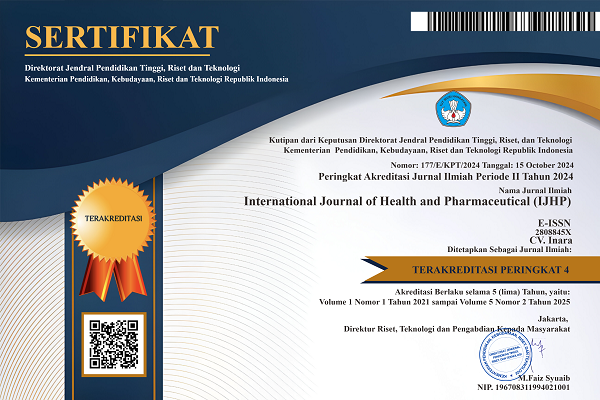The Relationship Of Sanitation And Refill Water Quality With Stunting Events In The Work Area of Community Health Centers Titi Papan in Medan Deli District
DOI:
https://doi.org/10.51601/ijhp.v2i1.26Keywords:
Drink water, sanitation, stuntingAbstract
Poor water quality is associated with various water-related diseases, as well as economic losses due to medical expenses and reduced productive days due to illness. According to him, proper drinking water is not necessarily safe. Sanitation is a public health effort that focuses on monitoring various environmental factors in the provision of clean water, disposal of human waste (latrines), waste management and waste water disposal that affect health status. Stunting is a condition where the child's growth is disturbed so that the child becomes shorter than the normal height of the child's age obtained from height measurements. This study aims to determine the quality of refilled water or drinking water consumed by families from refill drinking water depots or drinking water cooked by stunting families in the working area of Titi Papan Health Center. This type of research is descriptive research, with the research design is cross sectional. The result of this study is that sanitation and drinking water quality are significantly related to the incidence of stunting in the working area of the Titi Papan Public Health Center, Medan Deli District. The most dominant variable related to the incidence of stunting at the Titi Papan Health Center, Medan Deli District, was sanitation with a PR value of 16,212 and p<0.05, this means that good sanitation has 16 times the chance of not having stunting compared to poor sanitation.
Downloads
References
Owino, V., Ahmed, T., Freemark, M., & Kelly, P. (2016). Environmental Enteric Dysfunction and Growth Failure / Stunting in Global Child Health. Pediatrics 138(6):e2016064. https://doi.org/10.1542/peds.2016-0641
Soemirat. S, Environtmal Health, UGM, Yogyakarta, 2004, h. 10. WHO. 2013. Health Through Safe Drinking Water and Basic Sanitation. http://www.who.int/water_sanitation_health/mdg1/en/ accessed tgl 2 April 2014.
World Health Organization (2014). Global nutrition targets 2025 stunting policy brief. Geneva, Switzerland: World Health
Indonesian Ministry of Health. 2010. Guidelines for the Implementation of Sanitation Hygiene for Drinking Water Depots. Directorate of Environmental Health, Director General of PPPL: Jakarta.
Ministry of Health of the Republic of Indonesia, Regulation of the Minister of Health of the Republic of Indonesia No. 492/MENKES/PER/IV/2010. Regarding Drinking Water Quality Requirements. Jakarta: MOH; 2010
Notoatmodjo, Soekidjo. 2010. Health Research Methodology. Jakarta: Rineka Cipta
Downloads
Published
How to Cite
Issue
Section
License
Copyright (c) 2022 Sri Bulan Nasution, Endang Sofia S , Adi Rahmat, Murni Sari

This work is licensed under a Creative Commons Attribution-NonCommercial 4.0 International License.























